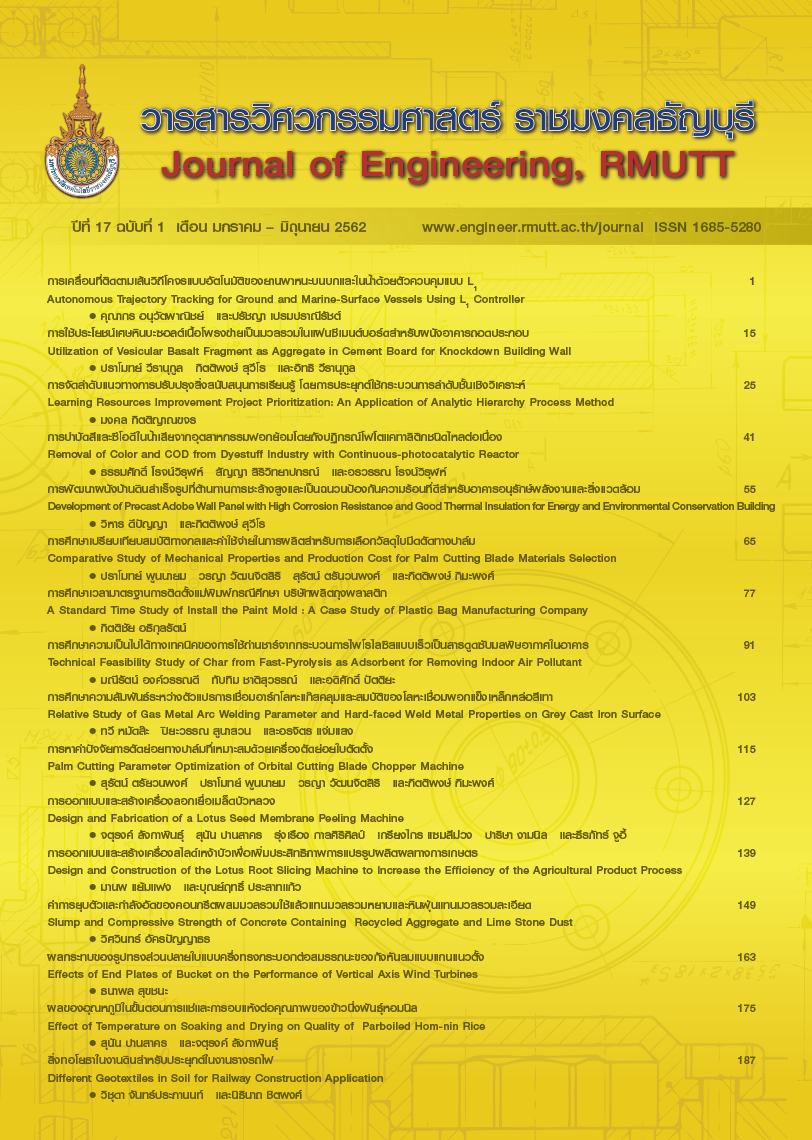การบำบัดสีและซีโอดีในน้ำเสียจากอุตสาหกรรมฟอกย้อม โดยถังปฏิกรณ์โฟโตแคทาลิติกชนิดไหลต่อเนื่อง
Main Article Content
บทคัดย่อ
งานวิจัยนี้เตรียมตัวเร่งปฏิกิริยาไทเทเนียมไดออกไซด์ (TiO2) แบบฟิล์มบางโดยใช้ตัวเร่งปฏิกิริยาในกระบวนการโฟโตแคทาลิติก และนำมาใช้ทดสอบประสิทธิภาพในการบำบัดสีและซีโอดีในน้ำเสียจากอุตสาหกรรมฟอกย้อมในถังปฏิกรณ์โฟโตแคทาลิติกชนิดไหลต่อเนื่องโดยใช้แหล่งกำเนิดแสงจากดวงอาทิตย์ ทั้งนี้น้ำเสียจากอุตสาหกรรมจากอุตสาหกรรมฟอกย้อมที่นำมาใช้มี 2 ลักษณะ ได้แก่ น้ำเสียก่อนและหลังผ่านการบำบัดโดยระบบบำบัดน้ำเสียแบบตะกอนเร่งของสถานประกอบการอุตสาหกรรมฟอกย้อม ผลการศึกษาในงานวิจัยนี้ พบว่า การใช้ตัวเร่งปฏิกิริยา TiO2 แบบฟิล์มบางที่เตรียมขึ้นเป็นตัวเร่งปฏิกิริยาในกระบวนการโฟโตแคทาลิติกสามารถบำบัดสีและซีโอดีในน้ำเสียทั้ง 2 ลักษณะที่นำมาใช้ทดสอบได้ โดยมีประสิทธิภาพในการบำบัดสีและซีโอดีสูงสุด เท่ากับ 39.85% และ 45.23% ตามลำดับ สำหรับน้ำเสียก่อนผ่านระบบบำบัดน้ำเสียของสถานประกอบการฯ โดยใช้เวลาในการบำบัด 300 นาที และมีประสิทธิภาพในการบำบัดสีและซีโอดีสูงสุด เท่ากับ 28.21% และ 44.41% ตามลำดับ สำหรับน้ำเสียหลังผ่านระบบบำบัดน้ำเสียของสถานประกอบการฯ โดยใช้เวลาในการบำบัด 300 นาที ทั้งนี้จากผลการศึกษาสามารถหาค่าจลนพลศาสตร์ของกระบวนการโฟโตแคทาลิติกในการบำบัดซีโอดีในน้ำเสียจากอุตสาหกรรมฟอกย้อมซึ่งสามารถอธิบายได้โดยสมการปฏิกิริยาอันดับหนึ่ง โดยสามารถหาค่าคงที่การเกิดปฏิกิริยาอันดับหนึ่งได้เท่ากับ 0.0121 และ 0.0107 min-1 ตามลำดับ สำหรับน้ำเสียก่อนและหลังผ่านการบำบัดโดยระบบบำบัดน้ำเสียของสถานประกอบการอุตสาหกรรมฟอกย้อม
Article Details
บทความ ข้อมูล เนื้อหา รูปภาพ ฯลฯ ที่ได้รับการตีพิมพ์ในวารสารแนวหน้าวิจัยนวัตกรรมทางวิศวกรรม ถือเป็นลิขสิทธิ์ของวารสารฯ เท่านั้น ไม่อนุญาติให้บุคคลหรือหน่วยงานใดคัดลอกเนื้อหาทั้งหมดหรือส่วนหนึ่งส่วนใดไปเผยแพร่เพื่อกระทำการใด ๆ ที่ไม่ถูกต้องตามหลักจริยธรรม
เอกสารอ้างอิง
Lin Y-C, Lee H-S. Effects of TiO2 coating dosage and operational parameters on a TiO2/Ag photocatalysis system for decolorizing Procion red MX-5B. Journal of Hazardous Materials. 2010;179(1–3):462-70.
Amani-Ghadim AR, Alizadeh S, Khodam F, Rezvani Z. Synthesis of rod-like α-FeOOH nanoparticles and its photocatalytic activity in degradation of an azo dye: Empirical kinetic model development. Journal of Molecular Catalysis A: Chemical. 2015;408:60-8.
Ge D, Zeng Z, Arowo M, Zou H, Chen J, Shao L. Degradation of methyl orange by ozone in the presence of ferrous and persulfate ions in a rotating packed bed. Chemosphere. 2016;146:413-8.
Yang R, Li D, Li A, Yang H. Adsorption properties and mechanisms of palygorskite for removal of various ionic dyes from water. Applied Clay Science. 2018;151(Supplement C):20-8.
Qiu Z-L, Kong X, Yuan J-J, Shen Y-J, Zhu B-k, Zhu L-P, et al. Cross-linked PVC/hyperbranched polyester composite hollow fiber membranes for dye removal. Reactive and Functional Polymers. 2018;122(Supplement C):51-9.
Zhang T, Xu B, Wang A, Cui C. Degradation kinetics of organic chloramines and formation of disinfection by-products during chlorination of creatinine. Chemosphere. 2018;195(Supplement C):673-82.
Tian F-X, Xu B, Lin Y-L, Hu C-Y, Zhang T-Y, Xia S-J, et al. Chlor(am)ination of iopamidol: Kinetics, pathways and disinfection by-products formation. Chemosphere. 2017;184 (Supplement C):489-97.
Nawaz MS, Ahsan M. Comparison of physico-chemical, advanced oxidation and biological techniques for the textile wastewater treatment. Alexandria Engineering Journal. 2014;53(3):717-22.
Jing L, Xu Y, Huang S, Xie M, He M, Xu H, et al. Novel magnetic CoFe2O4/Ag/Ag3VO4 composites: Highly efficient visible light photocatalytic and antibacterial activity. Applied Catalysis B: Environmental. 2016;199:11-22.
Zhong L, Haghighat F. Photocatalytic air cleaners and materials technologies - Abilities and limitations. Building and Environment. 2015;91:191-203.
Ohtsu N, Yokoi K, Saito A. Fabrication of a visible-light-responsive photocatalytic antibacterial coating on titanium through anodic oxidation in a nitrate/ethylene glycol electrolyte. Surface and Coatings Technology. 2015;262:97-102.
Bailón-García E, Elmouwahidi A, Álvarez MA, Carrasco-Marín F, Pérez-Cadenas AF, Maldonado-Hódar FJ. New carbon xerogel-TiO2 composites with high performance as visible-light photocatalysts for dye mineralization. Applied Catalysis B: Environmental. 2017;201:29-40.
Lai C, Wang M-M, Zeng G-M, Liu Y-G, Huang D-L, Zhang C, et al. Synthesis of surface molecular imprinted TiO2/graphene photocatalyst and its highly efficient photocatalytic degradation of target pollutant under visible light irradiation. Applied Surface Science. 2016;390:368-76.
Szczuka A, Parker KM, Harvey C, Hayes E, Vengosh A, Mitch WA. Regulated and unregulated halogenated disinfection byproduct formation from chlorination of saline groundwater. Water Research. 2017;122(Supplement C):633-44.
Rojviroon T, Laobuthee A, Sirivithayapakorn S. Photocatalytic Activity of Toluene under UV-LED Light with TiO2 Thin Films. International Journal of Photoenergy. 2012;2012:8.
Chen Q, Wu S, Xin Y. Synthesis of Au–CuS–TiO2 nanobelts photocatalyst for efficient photocatalytic degradation of antibiotic oxytetracycline. Chemical Engineering Journal. 2016;302:377-87.
El-Sheikh SM, Khedr TM, Hakki A, Ismail AA, Badawy WA, Bahnemann DW. Visible light activated carbon and nitrogen co-doped mesoporous TiO2 as efficient photocatalyst for degradation of ibuprofen. Separation and Purification Technology. 2017;173:258-68.
Zhou D, Chen Z, Yang Q, Dong X, Zhang J, Qin L. In-situ construction of all-solid-state Z-scheme g-C3N4/TiO2 nanotube arrays photocatalyst with enhanced visible-light-induced properties. Solar Energy Materials and Solar Cells. 2016;157:399-405.
Ministry of Natural Resources and Environment, Establish Standards for the Control of Industrial Sewerage Industrial Estate and Industrial Area. 2559: 17-21(In Thai)
C. S, N. S. Bactericidal and Detoxification Effects of Irradiated Semiconductor Catalyst, TiO2.Current Science. 2003;85(10):1431-8.
T. M, A. B, G. E, E. R. Algal Growth Inhibition on Cement Mortar: Efficiency of Water Repellent and Photocatalytic Treatments under UV/VIS Illumination. International Biodeterioration & Biodegradation. 2014;89:115-25.
M. B, Z. Z, X. X, X. Y, L. H, D. F. Killing Effects of Hydroxyl Radical on Algae and Bacteria in Ship’s Ballast Water and on Their Cell Morphology. Plasma Chemistry and Plasma Processing. 2010;30(6):831-40.
Zhang G, Wurtzler EM, He X, Nadagouda MN, O'Shea K, El-Sheikh SM, et al. Identification of TiO2 photocatalytic destruction byproducts and reaction pathway of cylindrospermopsin. Applied Catalysis B: Environmental. 2015;163(Supplement C):591-8.
Petronella F, Truppi A, Ingrosso C, Placido T, Striccoli M, Curri ML, et al. Nanocomposite materials for photocatalytic degradation of pollutants. Catalysis Today. 2017;281(Part 1):85-100.
Bagheri S, Muhd Julkapli N, Bee Abd Hamid S. Titanium Dioxide as a Catalyst Support in Heterogeneous Catalysis. The Scientific World Journal. 2014;2014:727496.
Chaturvedi S, Dave PN, Shah NK. Applications of nano-catalyst in new era. Journal of Saudi Chemical Society. 2012;16(3):307-25.
Homlok R, Takács E, Wojnárovits L. Degradation of organic molecules in advanced oxidation processes: Relation between chemical structure and degradability. Chemosphere. 2013;91(3):383-9.
Miao J, Zhang R, Zhang L. Photocatalytic degradations of three dyes with different chemical structures using ball-milled TiO2. Materials Research Bulletin. 2018;97(Supplement C):109-14.
Rojviroon T, Rojviroon O, Sirivithayapakorn S. Photocatalytic decolourisation of dyes using TiO2 thin film photocatalysts. Surface Engineering. 2016;32(8):562-9.
Aazam ES. Photocatalytic oxidation of methylene blue dye under visible light by Ni doped Ag2S nanoparticles. Journal of Industrial and Engineering Chemistry. 2014;20(6):4033-8.
Haritha E, Roopan SM, Madhavi G, Elango G, Al-Dhabi NA, Arasu MV. Green chemical approach towards the synthesis of SnO2 NPs in argument with photocatalytic degradation of diazo dye and its kinetic studies. Journal of Photochemistry and Photobiology B: Biology. 2016;162:441-7.


